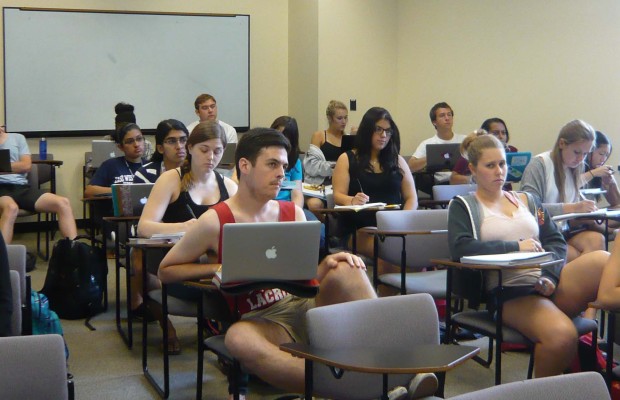Celebrity Diagnosis Goes to College!

A funny thing happened in December 2012.
Although we are always delighted to receive reader comments, I couldn’t help but notice that we were suddenly getting quite a lot of long and thoughtful contributions. After a little detective work, I discovered that these comments all were coming from “rice.edu”, i.e. Rice University in Houston, Texas and specifically from the students of Professor Kirsten Ostherr (pictured). As part of the course, Medicine & Media, her students were required to read and comment on an article of interest to them from our website.
We’re now working directly with Prof. Ostherr and are happy to announce that we will once again be a part of the Medicine & Media curriculum this fall.
But we’ve decided to amp things up a bit. Not only will students be submitting written comments, they will also be producing video comments.
Coming soon: A Special Section of the website where all the Rice University content will be available for viewing.
I recently interviewed Dr. Ostherr about this collaboration:
Dr. Berman: What is Medicine & Media?
Prof. Ostherr: Medicine & Media is an interdisciplinary course which explores the role of imaging technologies in the practice of medicine (described in my book Medical Visions) and the role of mass media in shaping our understandings of the body, health and disease.
Dr. B: What types of students take your class?
Prof. O: Most of my students are pre-med majors, but not all of them. The class draws students interested in media as well as medicine, and it also draws those interested in culture and representation more broadly. Majors are predominantly sciences and engineering, but I always hope to get a good mix of humanities and social science students, too! This class gives pre-medical students a broader view of the field of medical practice as it relates to other aspects of both doctors’ and patients’ lives - how their ideas about health and disease are shaped by their interactions with clinical and non-clinical representations, ranging from x-rays and fMRI (functional MRI) to Grey’s Anatomy and House, MD.
Dr. B: How long have you been offering this course?
Prof. O: I taught the very first version of this class back in 2007. I’ve adapted it continuously over the years, especially as the media shaping medicine have changed. Connected health has really exploded since then, so the class has emphasized more aspects of social media and web-based medical media. Since I started teaching this class, I also had the good fortune to meet Meg Marinis, formerly director of medical research for Grey’s Anatomy, (she’s now a writer for that show). Meg visited the class last time I taught it and this year she’s going to Skype in for a session.
I’ve also received grants to team-teach the class with MD-collaborators including Dr. Peter Killoran, an anesthesiologist and biomedical informaticist at Memorial Hermann hospital and University of Texas ; and Dr. Bryan Vartabedian who will visit the class again this semester. I believe that having multiple viewpoints from different disciplines really contributes to the overall value of the class and helps students begin to think across silos of knowledge as well - something they’ll need to be able to do in their future careers if they want to be transformative leaders!
Dr. B: How did you first learn about Celebrity Diagnosis?
Prof. O: Honestly, I’ve been a fan of the site for so long that I can’t remember! I must have found it during one of my Google searches for medicine, media, movies, television when I was looking to build out a list of recommended web sites for my students to engage with. It’s been since at least 2012.
Dr. B: Why did you want to incorporate it into your class?
Prof. O: I’ve always found that real-world, current events provide a great opportunity for students to apply the knowledge and theory they are learning in the class to broader issues. That work of translation is key to really understanding the course materials. I also think that, as future doctors, our students need to have the skills and confidence to engage in public dialogue around medicine. My colleague Dr. Vartabedian talks about this kind of engagement being an ethical responsibility for doctors, and I agree. He often uses the example of the MMR (measles, mumps, rubella) vaccine scandal, and how if MDs engaged in more public dialogue, the anti-vaccine movement wouldn’t have nearly the public presence that it has, or at least the conversation would be more balanced. It’s an ethical issue because lives are at stake! Also, it’s much more fun to write a blog post than it is to write a traditional academic paper. I’ve seen research showing that students’ writing is better, and they put more effort into it, when it is for peers rather than for their professors, and I believe it. Cultivating a personal yet semi-professional voice can be challenging, but it will serve them well throughout their careers.
Dr. B: How will students interact with Celebrity Diagnosis this year?
Prof. O: Students will produce their own responses to the posts on Celebrity Diagnosis on topics of interest to them. The goal is for them to relate the current events you cover to the conceptual frames, theoretical models, and historical perspectives that we are discussing in class. Their contributions will be comments on your “Teachable Moments” and not scholarly papers (there won’t be footnotes!), but I want them to think about how their readings and our dialogue might reframe their thinking about medicine and media in this most public of spheres - the world of celebrities and illness. Thank you for engaging in this experiment with us - I’m excited to have you as collaborators!
Dr. B: We’re delighted to be working with you and hope that our readers will enjoy seeing how your students enrich our work.



























0 comments